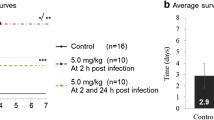Abstract
Human Recombinant IL-1 was investigated for its ability to increase non-specific resistance toStaphylococcus aureus in neutropenic mice. Mice, rendered neutropenic with cyclophosphamide and then administered IL-1 intraperitoneally, demonstrated enhanced resistance to subsequent challenge withS. aureus as measured by increased survival and bacterial clearance. No protective effects were observed with heat inactivated IL-1. Efficacy was observed only when both IL-1 and the subsequent bacterial challenge were administered into the same site. Despite the observed protective effects, animals treated with IL-1 did not have increased numbers of blood leukocytes or peritoneal phagocytes prior to infection or at the times coincident with bacterial clearance. Based upon these observations, enhanced activity of resident macrophages may be responsible for the protective effects observed in IL-1 treated mice.
Similar content being viewed by others
References
R.F. Kampschmidt,Infection, inflamation, and interleukin 1 (IL-1), Lymphokine Research,2 (3), 97–102 (1983).
C.A. Dinarello,An update on human interleukin-1: from molecular biology to clinical relevance. J. Clin. Immun.5 (5), 287–297 (1985).
J.R. Zucali, C.A. Dinarello, J. Oblon, M.A. Gross, L. Anderson and R.S. Weiner,Interleukin 1 stimulates fibroblasts to produce granulocyte-macrophage colony-stimulating activity and prostaglandin E 2 , J. Clin. Invest.77, 1857–1863 (1986).
S.N. Vogel, S.D. Douches, E.N. Kaufman and R. Neta,Induction of colony stimulating factor in vivo by recombinant interleukin 1 and recombinant tumor necrosis factor, J. Immun.138 (7), 2143–2148 (1987).
R.F. Kampschmidt and H.F. Upchurch,Possible involvement of leukocyte endogenous mediator in granulopoiesis, Proc. Soc. Exp. Biol. Med.155, 89–93 (1977).
J. Puri, B. Eglash and P. Lonai,Induction of Interferon-production and Ia expression by interleukin 1 in bone marrow culture cells, Eur. J. Immunol.17, 223–228 (1987).
A.D. Croll and A.G. Morris,The regulation of gamma interferon production by interleukin 1 and 2. Cell. Immun.102, 33–42 (1986).
J.D. Sipe, S.N. Vogel, S. Douches and R. Neta,Tumor necrosis factor/cachectin is a less potent inducer of serum amyloid A synthesis than interleukin 1, Lymphokine research,6 (2), 93–101 (1987).
C.A. Dinarello,Interleukin-1, Rev. Inf. Dis.6 (1), 51–95 (1984).
R. F. Kampschmidt and L. A. Pulliam,Stimulation of antimicrobial activity in the rat with leukocyte endogenous mediator, J. Reticuloendothel. Soc.17 (3), 162–169 (1975).
Y. Ozaki, T. Ohashi, A. Minami and S. Nakamura,Enhanced resistance of mice to bacterial infection induced by recombinant human interleukin-1a, Infect. Immun.55 (6), 1436–1440 (1987).
C.A. Dinarello, N.P. Golden and S.M. Wolff,Demonstration and characterization of two distinct human leukocyte pyrogens, J. Exp. Med.139, 1369–1381 (1974).
D.L. Dunn, R.A. Barke, N.B. Knight, E.W. Humphrey and R.L. Simmons,Role of resident macrophages, peripheral neutrophils, and translymphatic absorption in bacterial clearance from the peritoneal cavity, Infect. Immun.49 (2), 257–264 (1985).
D.D. Wood, E.K. Bayne, M.B. Goldring, M. Gowen, D. Hamerman, J.L. Humes, E.J. Ihrie, P.E. Lipsky and M.J. Starvch,The four biochemically distinct species of human interleukin 1 all exhibit similiar biologic activities. J. Immun.134 (2), 895–903 (1985).
M.S. Klempner and C.A. Dinarello,Stimulation of neutrophil oxygen dependent metabolism by human leukocytic pyrogen, J. Clin. Invest.64, 996–1002 (1979).
M.R.C. Banyard,Pyrexia, Disseminated intravascular coagulation and interleukin 1, Aust. Vet. Practit.16 (4), 191–193 (1986).
D. Metcalf, C.G. Begley, D.J. Williamson, E.C. Nice, J. Delamarter, J. Mermod, D. Thatcher and A. Schmidt,Hematopoietic responses in mice injected with purified recombinant murine GM-CSF, Exp. Hematol.15, 1–9 (1987).
K.H. Grabstein, D.L. Urdal, R.J. Tushinski, D.Y. Mochizuki, V.L. Price, M.A. Cantrell, S. Gillis and P.J. Conlon,Induction of macrophage tumoricidal activity by granulocyte-macrophage colony-stimulating factor, Science232, 506–508 (1986).
W.A. Jensen, R.M. Rose, A.S. Wasserman, T.H. Kalb, K. Antor and H.G. Remold,In vitro activation of the antibacterial activity of human pulmonary macrophages by recombinant interferon, J. Infect. Dis.155 (3), 574–577. (1987).
P.P. Singh, F. Gervais, E. Skamene and R.F. Mortensen,Serum amyloid P-component-induced enhancement of macrophage listericidal activity, Infect. Immun.52, (3), 688–694 (1986).
R.M. Schultz and M.G. Altom,Macrophage involvement in the antitumor activity of a synthetic acyltripeptide (FK-565) against experimental lung carcinoma metastases, J. Immunopharmac.8 (4), 515–528 (1986).
T.E. Schindler, R.G. Coffey and J.W. Hadden,Stimulatory effects of muramyl dipeptide and its butyl ester derivative on the proliferation and activation of macrophages in vitro. Int. J. Immunopharmac.8 (5), 487–498 (1986).
N.E. Byars,Two adjuvant-active muramyl dipeptide analogs induce differential production of lymphocyte-activating factor and a factor causing distress in guinea pigs. Infect. Immun.44 (2), 344–350 (1984).
Y. Osada, M. Mitsuyama, K. Matsumoto, T. Une, T. Otani, H. Ogawa and K. Nomoto,Stimulation of resistance of immunocompromised mice by a muramyl dipeptide analog. Infect. Immun.37 (3), 1285–1288 (1982).
Author information
Authors and Affiliations
Rights and permissions
About this article
Cite this article
Gladue, R., Girard, A. & Newborg, M. Enhanced antibacterial resistance in neutropenic mice treated with human recombinant interleukin-1 beta. Agents and Actions 24, 130–136 (1988). https://doi.org/10.1007/BF01968091
Received:
Accepted:
Issue Date:
DOI: https://doi.org/10.1007/BF01968091




